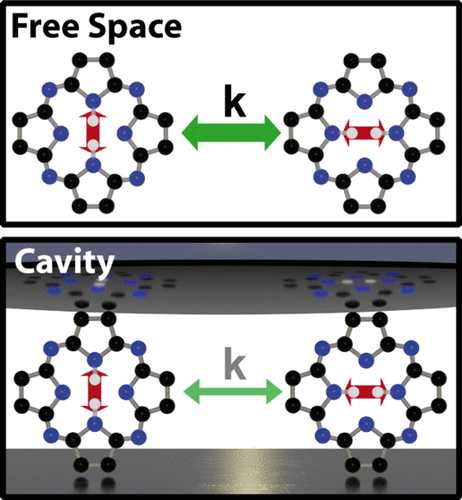Tailoring Tautomerization of Single Phthalocyanine Molecules through Modification of Chromophore Photophysics by the Purcell Effect of an Optical Microcavity
Takele, W. M., Wackenhut, F., Liu, Q., Piatkowski, L., Waluk, J., & Meixner, A. J.
J. Phys. Chem. C 2021, 125, 27, 14932–14939
Abstract
 Over the years, probing and controlling tautomerization has attracted significant attention because of its fundamental importance in various chemical and biological phenomena. So far, light, force, electrons, and electric field have been employed to alter the tautomerization characteristics in porphyrin and phthalocyanine derivatives. Here, we show that engineering the photophysics of molecules through interaction with the vacuum electromagnetic field in an optical microcavity can be used to control the tautomerization of single phthalocyanine molecules. Compared to the molecules embedded in a polymer matrix in open space, the average fluorescence lifetime inside the resonant microcavity decreases significantly due to the Purcell effect. The decreased lifetime reduces the possibility of a molecule entering into the triplet state, i.e., the photoactive tautomerization channel. As a result, the photoinduced tautomerization in phthalocyanine can be significantly altered. Our results demonstrate that the weak coupling between the excited state of a molecule and the vacuum electromagnetic field via a cavity mode can lead to significant changes in photoreactivity.
Over the years, probing and controlling tautomerization has attracted significant attention because of its fundamental importance in various chemical and biological phenomena. So far, light, force, electrons, and electric field have been employed to alter the tautomerization characteristics in porphyrin and phthalocyanine derivatives. Here, we show that engineering the photophysics of molecules through interaction with the vacuum electromagnetic field in an optical microcavity can be used to control the tautomerization of single phthalocyanine molecules. Compared to the molecules embedded in a polymer matrix in open space, the average fluorescence lifetime inside the resonant microcavity decreases significantly due to the Purcell effect. The decreased lifetime reduces the possibility of a molecule entering into the triplet state, i.e., the photoactive tautomerization channel. As a result, the photoinduced tautomerization in phthalocyanine can be significantly altered. Our results demonstrate that the weak coupling between the excited state of a molecule and the vacuum electromagnetic field via a cavity mode can lead to significant changes in photoreactivity.



